+ Open data
Open data
- Basic information
Basic information
| Entry | Database: PDB / ID: 2muy | ||||||
|---|---|---|---|---|---|---|---|
| Title | The solution structure of the FtsH periplasmic N-domain | ||||||
 Components Components | ATP-dependent zinc metalloprotease FtsH | ||||||
 Keywords Keywords | NUCLEOTIDE BINDING PROTEIN /  AAA ATPase / substrate recognition domain / AAA ATPase / substrate recognition domain /  metalloprotease metalloprotease | ||||||
| Function / homology | Signal recognition particle alu RNA binding heterodimer, srp9/1 - #210 / Signal recognition particle alu RNA binding heterodimer, srp9/1 / 2-Layer Sandwich / Alpha Beta / :  Function and homology information Function and homology information | ||||||
| Biological species |   Escherichia coli (E. coli) Escherichia coli (E. coli) | ||||||
| Method |  SOLUTION NMR / SOLUTION NMR /  simulated annealing, NOESY back-calculation simulated annealing, NOESY back-calculation | ||||||
| Model details | minimized average structure, model1 | ||||||
| Model type details | minimized average | ||||||
 Authors Authors | Scharfenberg, F. / Serek-Heuberger, J. / Martin, J. / Lupas, A.N. / Coles, M. | ||||||
 Citation Citation |  Journal: J.Mol.Biol. / Year: 2015 Journal: J.Mol.Biol. / Year: 2015Title: Structure and Evolution of N-domains in AAA Metalloproteases. Authors: Scharfenberg, F. / Serek-Heuberger, J. / Coles, M. / Hartmann, M.D. / Habeck, M. / Martin, J. / Lupas, A.N. / Alva, V. | ||||||
| History |
|
- Structure visualization
Structure visualization
| Structure viewer | Molecule:  Molmil Molmil Jmol/JSmol Jmol/JSmol |
|---|
- Downloads & links
Downloads & links
- Download
Download
| PDBx/mmCIF format |  2muy.cif.gz 2muy.cif.gz | 561.3 KB | Display |  PDBx/mmCIF format PDBx/mmCIF format |
|---|---|---|---|---|
| PDB format |  pdb2muy.ent.gz pdb2muy.ent.gz | 496.8 KB | Display |  PDB format PDB format |
| PDBx/mmJSON format |  2muy.json.gz 2muy.json.gz | Tree view |  PDBx/mmJSON format PDBx/mmJSON format | |
| Others |  Other downloads Other downloads |
-Validation report
| Arichive directory |  https://data.pdbj.org/pub/pdb/validation_reports/mu/2muy https://data.pdbj.org/pub/pdb/validation_reports/mu/2muy ftp://data.pdbj.org/pub/pdb/validation_reports/mu/2muy ftp://data.pdbj.org/pub/pdb/validation_reports/mu/2muy | HTTPS FTP |
|---|
-Related structure data
- Links
Links
- Assembly
Assembly
| Deposited unit | 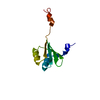
| |||||||||
|---|---|---|---|---|---|---|---|---|---|---|
| 1 |
| |||||||||
| NMR ensembles |
|
- Components
Components
| #1: Protein | Mass: 9545.575 Da / Num. of mol.: 1 / Fragment: N-domain (UNP residues 25-96) Source method: isolated from a genetically manipulated source Source: (gene. exp.)   Escherichia coli (E. coli) / Gene: ftsH, ECMDS42_2646 / Plasmid: pET28b / Production host: Escherichia coli (E. coli) / Gene: ftsH, ECMDS42_2646 / Plasmid: pET28b / Production host:   Escherichia coli (E. coli) / Strain (production host): C41(DE3) / References: UniProt: H0QE60 Escherichia coli (E. coli) / Strain (production host): C41(DE3) / References: UniProt: H0QE60 |
|---|
-Experimental details
-Experiment
| Experiment | Method:  SOLUTION NMR SOLUTION NMR | ||||||||||||||||||||||||||||||||||||||||||||||||||||
|---|---|---|---|---|---|---|---|---|---|---|---|---|---|---|---|---|---|---|---|---|---|---|---|---|---|---|---|---|---|---|---|---|---|---|---|---|---|---|---|---|---|---|---|---|---|---|---|---|---|---|---|---|---|
| NMR experiment |
|
- Sample preparation
Sample preparation
| Details |
| ||||||||||||||||||||||||||||
|---|---|---|---|---|---|---|---|---|---|---|---|---|---|---|---|---|---|---|---|---|---|---|---|---|---|---|---|---|---|
| Sample |
| ||||||||||||||||||||||||||||
| Sample conditions | Ionic strength: 0.105 / pH: 7.2 / Pressure: ambient / Temperature: 298 K |
-NMR measurement
| NMR spectrometer |
|
|---|
- Processing
Processing
| NMR software |
| ||||||||||||||||||||||||||||||||
|---|---|---|---|---|---|---|---|---|---|---|---|---|---|---|---|---|---|---|---|---|---|---|---|---|---|---|---|---|---|---|---|---|---|
| Refinement | Method:  simulated annealing, NOESY back-calculation / Software ordinal: 1 simulated annealing, NOESY back-calculation / Software ordinal: 1 | ||||||||||||||||||||||||||||||||
| NMR constraints | Protein chi angle constraints total count: 41 / Protein other angle constraints total count: 13 / Protein phi angle constraints total count: 63 / Protein psi angle constraints total count: 63 | ||||||||||||||||||||||||||||||||
| NMR representative | Selection criteria: minimized average structure | ||||||||||||||||||||||||||||||||
| NMR ensemble | Conformer selection criteria: structures with the least restraint violations Conformers calculated total number: 100 / Conformers submitted total number: 20 / Maximum lower distance constraint violation: 0.07 Å / Maximum torsion angle constraint violation: 0.6 ° / Maximum upper distance constraint violation: 0.09 Å | ||||||||||||||||||||||||||||||||
| NMR ensemble rms | Distance rms dev: 0.011 Å / Distance rms dev error: 0.001 Å |
 Movie
Movie Controller
Controller



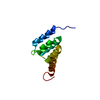

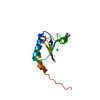



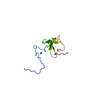

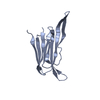

 PDBj
PDBj